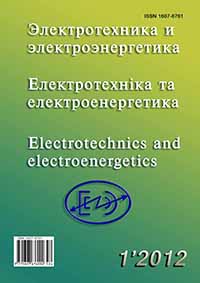Power and control performance of an optimal vector-controlled induction motor drives
DOI:
https://doi.org/10.15588/1607-6761-2012-1-10Keywords:
induction motor drive, power and control performance, optimal vector control, torque maximizationAbstract
The comparison of the criteria optimization of vector-controlled (VC) induction motor drive (IMD) is described. The dependences of the optimal power and control performance that explain the nature of electromagnetic process in the IMD with the VC are obtained. These dependences allow to estimate the opportunities of the investigated control method and select an induction motor for solving the particular task.References
Sang-Hoon, Kim Voltage Control Strategy for Maximum Torque Operation of an Induction Machine in the Field Weakening Region / Sang-Hoon Kim, Seung-Ki Sul // IECON. – 1994. – V1 – Pp. 599–604.
Jinhwan, Jung A Dynamic Decoupling Control Scheme for High-Speed Operation of Induction Motors / Jinhwan Jung, Kwanghee Nam // IEEE Trans оn Industrial Electronics. – 1999. – Vol. 46, N 1. – Pp. 100–110.
Jul-Ki, Seok Optimal Flux Selection of an Induction Machine for Maximum Torque Operation in Flux-Weakening Region / Jul-Ki Seok, Seung-Ki Sul // IEEE Trans. on Power Electronics. –1999. – Vol. 14, N 4. – Pp. 700–708.
Fernando Briz, del Blanco Dynamic Analysis of Current Regulators for AC Motors Using Complex Vectors / F. B. Blanco, M. W.Degner, R. D. Lorenz // IEEE Trans. on Industry applications. – 2001. – Vol. 37, N 1. – Pp. 42–50.
Briz, F. Current and Flux Regulation in Field-Weakening Operation / F. Briz, A. Diez, M. W. Degner // IEEE Trans. on Industry applications. – 1999. – Vol. 35, N 6. – Pp. 1424–1432.
Harnefors, L. Torque-Maximizing Field-Weakening Control: Design, Analysis, and Parameter Selection / L. Harnefors, K. Pietilainen, L. Gertmar // IEEE Trans. on Industrial Electronics. – 2001. – Vol. 48, N 1. – Pp. 161–168.
Myoung-Ho, Shin Maximum Torque Control of Stator-Flux-Oriented Induction Machine Drive in the Field-Weakening Region / M. Shin, D. Hyun, S. Cho // IEEE – Trans. on Industry Applications –2002. – Vol. 38, N 1. – Pp. 117–122.
Emil, Levi A Speed Estimator for High Performance Sensorless Control of Induction Machines Above Base Speed / Emil Levi, Mingyu Wang // EPE-PEMC 2002 –Dubrovnic&Cavlat. – Pp. 1–11.
Gallegos-Lopes, G. Current Control of Induction Machines in the Field-Weakened Region / G. GallegosLopes, F. S. Gunawan, J. E. Walters // IEEE Trans. on Industry applications. – 2007. – Vol. 43, N 4. – Pp. 981–989.
A. Ben, Ali, Torque Maximization and Sensorless Control of Induction Motor in a Flux Weakening Region / A. Ben Ali, A. Khedher, M.F.Mimouni, R. Dhifaoui // Internal Journal of Sciences and Techniques of Automatic control & computer engineering. – 2009, IJ-STA. – Vol. 3, N1. – Pp. 972–985.
Пересада, С. М. Обобщенное решение задачи косвенного векторного управления моментом асинхронных двигателей с максимизацией соотношения момент-токв статике / С. М. Пересада, С. С. Дымко, С. Н. Ковбаса // Вісник Національного технічного університету «ХПІ». – 2010. –№ 28. –С. 700.
Потапенко, Е. М. Робастные алгоритмы векторного управления асинхронным приводом / Е. М. Потапенко, Е. Е. Потапенко. –Запорожье : ЗНТУ. – 2009. –С. 352.
Виноградов, А. Б. Векторное управление электроприводами переменного тока / Виноградов А. Б. –ГОУВПО «Ивановский государственный энергетический университет имени В.И. Ленина». Иваново, 2008. – 298 с.
Vas, P. Sensorless Vector and Direct Torque Control / Vas P. – Oxford : Oxford University Press, 1998. – 729 p.
Novotny, D. W. Vector Control and Dynamics of AC Drives / D. W. Novotny and T. A. Lipo. – Oxford : Oxford University Press, 1996. – 440 p.
Булгаков, А. А. Частотное управление асинхронными двигателями / Булгаков А. А. – М. : Энергоиздат, 1982. – 216 с.
Півняк, Г. Г. Сучасні частотно-регульованіасинхронні електроприводи з широтно-імпульсною модуляцією : монографія / Г. Г. Півняк, О. В. Волков. – Дніпропетровськ : Національний гірничий університет, 2006. – 470с.
Downloads
How to Cite
Issue
Section
License
Copyright (c) 2017 А. А. Shiyka, E. M. Potapenko

This work is licensed under a Creative Commons Attribution 4.0 International License.
Creative Commons Licensing Notifications in the Copyright Notices
Authors who publish with this journal agree to the following terms:
Authors retain copyright and grant the journal right of first publication with the work simultaneously licensed under aCreative Commons Attribution License that allows others to share the work with an acknowledgement of the work's authorship and initial publication in this journal.
Authors are able to enter into separate, additional contractual arrangements for the non-exclusive distribution of the journal's published version of the work (e.g., post it to an institutional repository or publish it in a book), with an acknowledgement of its initial publication in this journal.
Authors are permitted and encouraged to post their work online (e.g., in institutional repositories or on their website) prior to and during the submission process, as it can lead to productive exchanges, as well as earlier and greater citation of published work.

